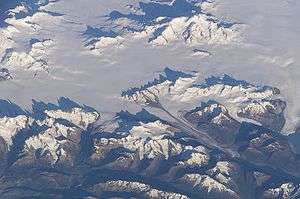Argentine irredentism

Argentine irredentism is the idea of Argentina's sovereignty over the British Overseas Territories of the Falkland Islands, South Georgia and the South Sandwich Islands, along with the dispute with Chile over the Southern Patagonian Ice Field and disputes with both over the region designated as Argentine Antarctica.
Neighbour countries
Modern Argentina was once part of a Spanish viceroyalty, the Viceroyalty of the Río de la Plata, whose administrative capital was Buenos Aires. The Argentine War of Independence broke the ties to Spain, but started as well a process of Balkanization, as the administrative dependencies of the viceroyalty had weak links with each other. Once the wars of independence and the civil wars ended, the viceroyalty was replaced by four countries: Argentina, Bolivia, Paraguay and Uruguay. Revisionist historian Vicente Quesada began the territorial nationalism in Argentina, envisioning the territory of the Viceroyalty as a sort of "Great Argentina", the national limits the country should have had, which fell into Balkanization by a mixture of foreign interventions by Britain and Brazil, the apathy of the Unitarian Party, and poor Argentine diplomacy.[1] This view, disdainful of the neighbour countries, was crafted in the 1880s decade, influenced by the Argentine territorial expansion caused by the Conquest of the desert and by the Great European immigration wave to Argentina.[2]
According to Quesada, Juan Manuel de Rosas and Bartolomé Mitre would have led policies attempting to revert the Balkanization, at least partially.[3] However, there is no documented interest of Rosas in the anexation of Bolivia, or just the Tarija province, maintaining the apathy of Bernardino Rivadavia over it.[4] According to the mainstream Uruguayan historiography, the main goal of Rosas during the war with Uruguay was to destroy the economic power of Montevideo, a rival port of Buenos Aires since colonial times.[5] Paraguay stayed neutral during the Argentine Civil Wars during Gaspar Rodríguez de Francia's rule, not allowing even the political asylum of the Unitarians; Rosas stayed in good terms with Paraguay for this.[5] When Carlos Antonio López proclaimed the independence of Paraguay in 1842, Rosas did not take a defined position towards it (he did not accept or reject it) but sold weapons to López and did not take any military action against Paraguay, in order to maintain him in a neutral position in the civil wars.[6]
Falkland Islands
The Argentine government has maintained a claim over the Falkland Islands since 1833, and renewed it as recently as June 2009.[7] It considers the archipelago part of the Tierra del Fuego Province, along with South Georgia and the South Sandwich Islands.
The Argentine claim is included in the transitional provisions of the Constitution of Argentina as amended in 1994:[8][9]
The Argentine Nation ratifies its legitimate and non-prescribing sovereignty over the Malvinas, Georgias del Sur and Sandwich del Sur Islands and over the corresponding maritime and insular zones, as they are an integral part of the National territory. The recovery of these territories and the full exercise of sovereignty, respecting the way of life for its inhabitants and according to the principles of international law, constitute a permanent and unwavering goal of the Argentine people.

Southern Patagonian Ice Field
50 kilometres (31 mi) of the Chile–Argentina border, between Mount Fitzroy and Cerro Murallón, remain undefined,[10][11] on the extrapolar ice field of Southern Patagonia. This desolate uninhabitable region is the last remaining border dispute between Chile and Argentina, outside of Antarctica. In August 1991 the governments of Chile and Argentina had agreed on a borderline,[12] but it was never ratified by the Argentine parliament due to its supposed favoring of Chile. The Argentine Parliament believed the border needed to be pushed farther west to encompass a larger part of the ice field as it provides a large deposit of fresh water,[13] but the Chilean government felt it was already pushed too far west thinning their already thin strip of land in the region.[13] The dispute would come up for demarcation again in 1994, 1998, 2006 and 2009; however no official boundary has ever been reached.[14][15]
See also
Bibliography
- Cavaleri, Paulo (2004). La restauración del Virreinato: orígenes del nacionalismo territorial Argentino (in Spanish). Buenos Aires: Universidad Nacional de Quilmes. ISBN 987-558-031-7.
References
- ↑ Cavaleri, pp. 11-13
- ↑ Cavaleri, p. 14
- ↑ Cavalieri, p. 17
- ↑ Cavalieri, p. 20
- 1 2 Cavalieri, p. 21
- ↑ Cavalieri, p. 22
- ↑ "Malvinas: la ONU hará más gestiones para abrir el diálogo". Lanacion.com.ar. Retrieved 2010-03-15.
- ↑ "Constitución Nacional" (in Spanish). 22 August 1994. Retrieved 17 June 2011.
- ↑ "Constitution of the Argentine Nation". 22 August 1994. Retrieved 17 June 2011.
- ↑ "Border agreement between Chile and Argentina". Archived from 1998 the original Check
|url=value (help) on 2007-01-17. Retrieved 2006-10-27. - ↑ "Map showing border between Chile and Argentina (partly undefined)". Retrieved 2006-10-27.
- ↑ "Chile and Argentina: from measures of trust to military integration". Military Review. 2007.
- 1 2 http://en.mercopress.com/2010/05/20/argentina-revives-long-time-border-dispute-with-chile-in-patagonian-ice-fields
- ↑ http://edant.clarin.com/diario/2006/08/30/um/m-01262333.htm
- ↑ http://www.microsofttranslator.com/BV.aspx?ref=IE8Activity&a=http%3A%2F%2Fedant.clarin.com%2Fdiario%2F2006%2F08%2F30%2Fum%2Fm-01262333.htm
External links
- Expedición Transpatagonia 2007, Campo de Hielo Patagónico Sur. Primera exploración histórica del Cordón del Gaviotín y del Lago Greve
- Subsecretario argentino de turismo dice que mapa de Campos de Hielo es oficial "El Mercurio", Chile 29 August 2006
- Hielos Continentales: reclamo de Chile por los mapas argentinos Clarín, Argentina 29 August 2006
- Tras la fricción por los Hielos Continentales, la Argentina llama a Chile a demarcar los límites "lo antes posible" Clarín, 30 August 1996
- Argentine Bases
- Marambio Base (Spanish/English)
- Dirección Nacional del Antártico: Bases
- Argentine Antarctica History (Spanish)